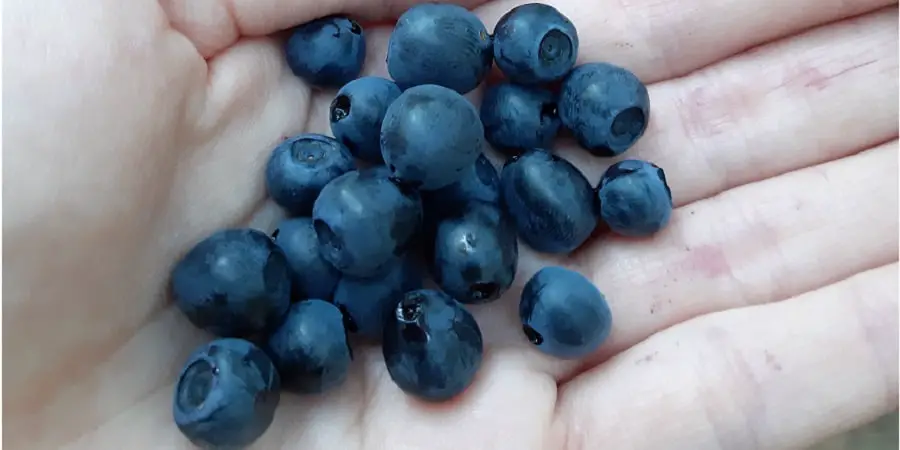Although the Norwegian winter can be very cold and snowy, nature is warm and giving during the summer months. In addition to its long, bright days and midnight sun, Norwegian nature offers great opportunities to go berry hunting.
From June to September Norwegian forests transform into berry heavens. These delicious treasures such as wild strawberries, blueberries, raspberries, cloudberries, and so on, can be handpicked by you, in almost every corner of Norway.
Norwegian people love outdoor activities, including walking long walks in the mountains and forests. So when you happen to be in Norway, why not try to adapt to the local people and habits, and make sure to bring something to pick berries into.

The Norwegian berry season
While the seasons vary slightly from north to south and depending on the weather, the various types of berries you can find in Norway tend to be in season during the following months:
- Wild strawberries: Early June till July.
- Blueberries (bilberries): Mid-July till August.
- Raspberries: Mid-July till August.
- Lingonberries: Late July till September.
- Cloudberries: Late August to September
Blueberries (blåbær)
The most common blueberry type found in Norway is the European blueberry (Vaccinium myrtillus), commonly called bilberry. It is native to Northern Europe, the British Isles, Ireland, Iceland, and across the Caucasus into northern Asia.
The plants appear as small bushes and grow between 20 and 30 centimeters high. Blueberries are used for juice and jam but in my opinion, they are best eaten fresh, straight off the bush.
Blue/bilberries can be found virtually anywhere throughout Norway. That being said, they tend to grow in areas with acidic soil of which there is plenty in Norway, especially inland and up toward the mountains.
Here the climate is also a little cooler, and they don’t get excessive amounts of sun which is their ideal environment. That being said, there tend to be a lot more blueberries if we are lucky to have a warm summer.
Blue/bilberries can be handpicked straight off the bush, however, If you want to speed up the picking process, you should get a berry picker. This will enable you to pick a full bucket in no time, which is more than enough to make delicious wild blueberry jam to enjoy on your pancakes the next morning.
How to make blueberry jam at home
As mentioned, one way to enjoy your hand-picked blue/bilberries is to turn them into delicious jam. Homemade blueberry jam is way fresher than store-bought one. Also, store-bought blueberry jams tend to be made with large quantities of sugar, as it is cheaper. However, if you make your own, you can determine how much sugar to use and create a healthier jam.
Last summer I managed to pick a few kilos of fresh wild blueberries by using a berry picker. Before making the jam, you will have to rinse them. This can be boring, but you can speed up the process using a berry rinser. Also, pasta rinser will do pretty much the same job.
You then simply put the berries in a large pot and mash them to bring the juice out. Then you add your desired amount of sugar and bring it to a boil. While you can decide how sweet you want your jam to be, I like to use about 25% sugar.
Once it has boiled for a couple of minutes, transfer the jam into mason jars. Try to use sterilized glasses (boil them in water before use) to get a sterile seal to allow for longer storage. That way you can enjoy your tasty blueberry jam all year round. To help guide you, check out the video on how to make blueberry jam below.
What is the difference between bilberries and American blueberries?
The blue/bilberries found in the wild in Norway are different from the commercial American-type blueberries.
First and foremost, bilberries have dark red, very aromatic flesh, and red juice. The American blueberries have white or semi-transparent, mildly fragrant flesh. The red juice of the bilberry fruit will stain hands, teeth, and tongue while eating, while American blueberries have a less intense color, thus less staining.
Bilberries grow on low bushes with solitary fruits, while American blueberries grow on large bushes with the fruit in bunches, which enables easier commercial cultivation. Bilberry shrubs can be cultivated, but not for commercial use.
Finally, when cooked, bilberries have a much stronger flavor and a rougher texture than American blueberries
Wild strawberries (Markjordbær)
Norwegian wild strawberry (Fragaria vesca), also known as woodland strawberry, Alpine strawberry, and European strawberry is a wild type of strawberry that grows all over Norway during the summer.
The plants are 5-20 cm high and form little white flowers before fruiting which results in small, berry-sized, sweet strawberries that you can pick right off the bush. They spread through new offshoots along the ground, forming clusters that multiply easily.
You can find these small strawberry plants on meadows, dry slopes, and herbaceous forests, mostly on slightly nutritious soil. Sometimes you come across them along the roadside. While sweet and tasty, they are not as numerous as other berries on this list, but they are sure worth a taste if you come across them.
Cloudberries (Multer/Molter)
The cloudberry (Rubus chamaemorus) is a delicate and tasty fruit that grows in the cool temperate and alpine regions of the northern hemisphere.
The plant grows between 5 and 20 cm high and produces a single-flowered white flower when they bloom in late spring/early summer. Despite being native to the tough climate of the north, their ability to fruit is very temperature sensitive.
A night of early frost can destroy any hope of finding its delicious fruit, but if the conditions are right, the small plants can produce vast amounts of amber-colored, delicious, and juicy fruit. The berries/fruit look similar to the raspberry or blackberry, but have a pale yellow to orange color, and are very rich in vitamin C.
You tend to find cloudberries on low-calcium peat soil, swamp forest, and heather moors in the highlands all the way up to 1400 meters above sea level. If you are lucky enough to find them when the season is good, you can enjoy them as jam, in cakes, or cloudberry sauce, or even liqueur.
Wild raspberries (Bringebær)
While there are different types of raspberry bushes, the most common raspberry type in Norway is the red raspberry bush (Rubus idaeus), also called the European raspberry.
It is native to Europe and northern Asia and grows to about 1 meter tall bush. They bloom in late spring/early summer before producing red, tasty fruits. Interestingly the fruit is not a berry at all, but an aggregate fruit of numerous drupelets, each having its own seed, around a central core.
Raspberry bushes are found throughout forests and among the shrubs along roads and sidewalks. If you find one bush, you are likely to find another close by. Because of their size, they give off quite a lot of fruit, often enough to decorate a cake or make some delicious jam for your waffles.
Lingonberries (Tyttebær)
Lingonberry (Vaccinium vitis-idaea) is considered to be one of the most important berries in Norway. This is in large part due to the importance of lingonberry jam in Norwegian cuisine.
Commonly called partridgeberry, mountain cranberry, or cowberry. This small bush plant is native to boreal forests throughout the Northern Hemisphere from Eurasia to North America. They are plentiful throughout the Norwegian forests and can be picked in the wild in huge numbers from late August through September. They are typically found in the same areas where you find blueberries, which are acidic soil.
The lingonberries are almost exclusively used to make jam which is served alongside a variety of Scandinavian dishes, especially moose and elk, but also meatballs and pork. For example, if you ever have tried Swedish meatballs in IKEA, you have the choice of getting some lingonberry jam on the side.
